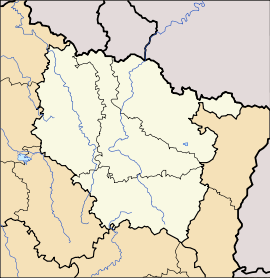Moussey, Vosges
| Moussey | |
|---|---|
 | |
 Moussey | |
|
Location within Lorraine region  Moussey | |
| Coordinates: 48°25′51″N 7°01′25″E / 48.4308°N 7.0236°ECoordinates: 48°25′51″N 7°01′25″E / 48.4308°N 7.0236°E | |
| Country | France |
| Region | Alsace-Champagne-Ardenne-Lorraine |
| Department | Vosges |
| Arrondissement | Saint-Dié-des-Vosges |
| Canton | Senones |
| Intercommunality | Association of Senones Country communes |
| Government | |
| • Mayor (2008–2014) | Bertrand Klein |
| Area1 | 29.2 km2 (11.3 sq mi) |
| Population (2006)2 | 731 |
| • Density | 25/km2 (65/sq mi) |
| INSEE/Postal code | 88317 / 88210 |
| Elevation |
360–933 m (1,181–3,061 ft) (avg. 380 m or 1,250 ft) |
|
1 French Land Register data, which excludes lakes, ponds, glaciers > 1 km² (0.386 sq mi or 247 acres) and river estuaries. 2 Population without double counting: residents of multiple communes (e.g., students and military personnel) only counted once. | |
Moussey is a commune in the Vosges department in Lorraine in northeastern France.
Inhabitants are called Mousséens.
Geography
Positioned on the eastern side of Lorraine, the village of Moussey is the last inhabited settlement along the Senones Valley before, eventually, the road crosses the Prayé Pass (Col de Prayé) into Alsace and on to Mont Donon, the highest peak in the North Vosges Mountains.
History
The name 'Moussey' comes from the Latin word 'Monticellus' meaning 'little mountain'. The village is set on a small hill at the foot of which a fast flowing mountain stream fully deserves its name, the River Rabondeau (in Latin, 'rapidus aqua' / 'fast water').
Moussey is one of several communes that formerly belonged to Senones Abbey: subsequently it fell within the Principality of Salm-Salm until the French Revolution, following which the former principality became a part of France. Numerous documents from the 18th century, now archived at the mairie testify to the way the princes of Salm-Salm were happy to accommodate the presence of such prominent religious scholars as Dom Calmet.
Fortune arrived Moussey in the 19th century thanks to the textile industry. The first textile mill was constructed in 1836: an adjoining chateau was built between 1858 and 1863. The business was operated successively by three families, being the Charlot, Lung et Laederich families, but in 1966 the machines fell silent. Since 1988 various surviving elements of the Moussey textile business have enjoyed protected historical monument status.
During the Second World War, the Resistance was active in the valley, which led to a major deportation of men from the Rabodeau Valley. Moussey lost 187 of whom 144 never returned. Among the deportees was the man who had been mayor since 1917, the director general of the Laederich Business: Jules Py died at Dachau on 24 January 1945.
See also
References
| Wikimedia Commons has media related to Moussey (Vosges). |